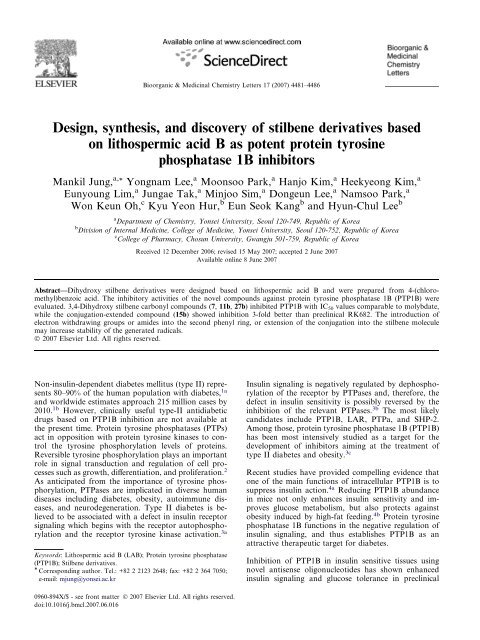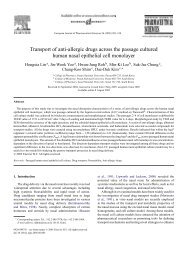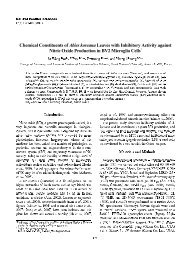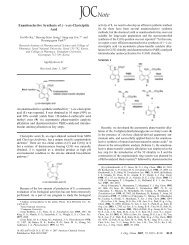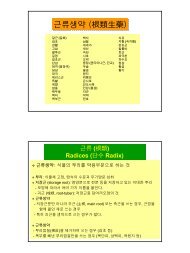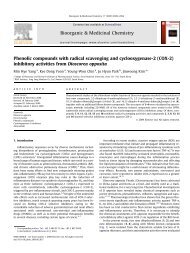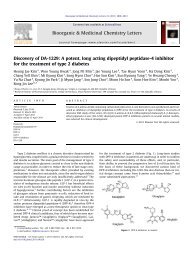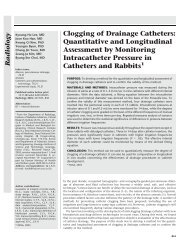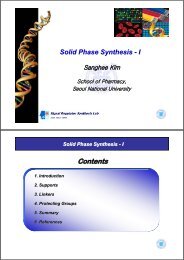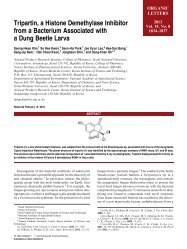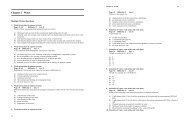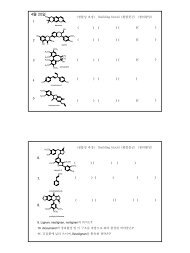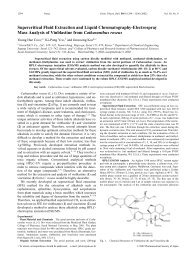Design, synthesis, and discovery of stilbene derivatives based on ...
Design, synthesis, and discovery of stilbene derivatives based on ...
Design, synthesis, and discovery of stilbene derivatives based on ...
You also want an ePaper? Increase the reach of your titles
YUMPU automatically turns print PDFs into web optimized ePapers that Google loves.
4482 M. Jung et al. / Bioorg. Med. Chem. Lett. 17 (2007) 4481–4486models. 4c However, there are very few PTPase inhibitorsthat have been advanced into clinical trials.Small molecule PTP1B inhibitors may find an importantclinical role as novel insulin sensitizers in the treatment<str<strong>on</strong>g>of</str<strong>on</strong>g> type II diabetes. 4d,e Lithospermic acid B (LAB) 5 1 isa polyphenol compound extracted from Salvia miltorrhizaBunge. Although LAB itself shows no in vitro inhibiti<strong>on</strong><str<strong>on</strong>g>of</str<strong>on</strong>g> PTP1B, it was shown to reduce the glomerular proteinuriain in vivo experiments, <str<strong>on</strong>g>and</str<strong>on</strong>g> to show a str<strong>on</strong>gin vitro aldose reductase inhibiti<strong>on</strong> <str<strong>on</strong>g>and</str<strong>on</strong>g> has been studiedas an antidiabetic drug c<str<strong>on</strong>g>and</str<strong>on</strong>g>idate. 6 In structural aspects,it is tetramer <str<strong>on</strong>g>of</str<strong>on</strong>g> caffeic acid with seven phenolic hydroxylgroups, which cause the antioxidant effect <str<strong>on</strong>g>of</str<strong>on</strong>g> thiscompound.HOHOOHOHO 2 COOO1OOHOHCO 2 HIn this article, we wish to report the design, <str<strong>on</strong>g>synthesis</str<strong>on</strong>g>,<str<strong>on</strong>g>and</str<strong>on</strong>g> <str<strong>on</strong>g>discovery</str<strong>on</strong>g> <str<strong>on</strong>g>of</str<strong>on</strong>g> dihydroxy <str<strong>on</strong>g>stilbene</str<strong>on</strong>g> <str<strong>on</strong>g>derivatives</str<strong>on</strong>g> <str<strong>on</strong>g>based</str<strong>on</strong>g><strong>on</strong> natural lithospermic acid B as potent PTP1Binhibitors.Since LAB has high molecular weight <str<strong>on</strong>g>and</str<strong>on</strong>g> polarity, itdoes not satisfy the Lipinski’s rule for potential drug c<str<strong>on</strong>g>and</str<strong>on</strong>g>idateswith good bioavailability. 7a High molecularweight makes LAB unsuitable for further derivatizati<strong>on</strong>,so we sought a novel simplified lead compound with lowmolecular weight that retained high antioxidant effect.We found that <str<strong>on</strong>g>stilbene</str<strong>on</strong>g> <str<strong>on</strong>g>derivatives</str<strong>on</strong>g> (7) inhibited PTP1Bwith an IC 50 = 25.6 lM in preliminary studies. Recently,novel <str<strong>on</strong>g>stilbene</str<strong>on</strong>g> analogs were reported as potent humancytochrome P450 inhibitors. 8 The <str<strong>on</strong>g>stilbene</str<strong>on</strong>g> derivative isa neutral molecule without charge, having a structurewell-suited to derivatizati<strong>on</strong>. We proposed the lead compoundstructure 15 to be a derivative <str<strong>on</strong>g>of</str<strong>on</strong>g> the caffeic aciddimer, the central part <str<strong>on</strong>g>of</str<strong>on</strong>g> LAB 1 with two phenolichydroxyl groups <strong>on</strong> the phenyl ring as a stable radicalgenerator. This molecule is a sort <str<strong>on</strong>g>of</str<strong>on</strong>g> trans-<str<strong>on</strong>g>stilbene</str<strong>on</strong>g>, inwhich two benzene rings are c<strong>on</strong>nected via <strong>on</strong>e doubleb<strong>on</strong>d, derived from the core structure <str<strong>on</strong>g>of</str<strong>on</strong>g> the LAB. Itsatisfies the Lipinski’s rule. 7a Two phenolic hydroxylgroups <str<strong>on</strong>g>and</str<strong>on</strong>g> the c<strong>on</strong>jugati<strong>on</strong> throughout the whole systemmay c<strong>on</strong>tribute to the expected high radical scavengingeffect by increasing stability <str<strong>on</strong>g>of</str<strong>on</strong>g> the generated radicals.OHOHFigure 1 shows the delocalizati<strong>on</strong> <str<strong>on</strong>g>of</str<strong>on</strong>g> spin density <str<strong>on</strong>g>of</str<strong>on</strong>g> thephenolic O-centered radical, which was calculated usingTitan program with DFT/6-31G method. The spin densityis delocalized throughout the whole structure <str<strong>on</strong>g>of</str<strong>on</strong>g> thiscompound due to the planarity <str<strong>on</strong>g>and</str<strong>on</strong>g> the aromaticity <str<strong>on</strong>g>of</str<strong>on</strong>g>the structure. Two hydroxyl groups attached to the centralphenyl ring have been removed to reduce the hydrophilicity<str<strong>on</strong>g>of</str<strong>on</strong>g> the compound. Moreover, the terminalcarboxylic acid group can be substituted to make <str<strong>on</strong>g>derivatives</str<strong>on</strong>g>with improved physical <str<strong>on</strong>g>and</str<strong>on</strong>g> chemical properties.It is suitable for assessment by medicinal chemistry, asit satisfied the lead likeness rule proposed by Teagueet al. 7b We can expect high radical scavenging effects<str<strong>on</strong>g>and</str<strong>on</strong>g> l<strong>on</strong>g half-life for this compound because the spindensity generated at the para positi<strong>on</strong> hydroxyl groupthrough interacti<strong>on</strong> with other radicals can be delocalizedthroughout the c<strong>on</strong>jugated structure. In additi<strong>on</strong>,the radical at the para hydroxyl group can be stabilizedto form a hydrogen b<strong>on</strong>d with the meta-positi<strong>on</strong> hydroxylgroup. Therefore, we expect this compound <str<strong>on</strong>g>and</str<strong>on</strong>g> its<str<strong>on</strong>g>derivatives</str<strong>on</strong>g> to be useful as potent antioxidants with highradical scavenging effects that can eventually be developedas anti-diabetic drug c<str<strong>on</strong>g>and</str<strong>on</strong>g>idates.For initial assessment <str<strong>on</strong>g>of</str<strong>on</strong>g> the structure–activity relati<strong>on</strong>ship,the chemical structures <str<strong>on</strong>g>of</str<strong>on</strong>g> <str<strong>on</strong>g>stilbene</str<strong>on</strong>g> <str<strong>on</strong>g>derivatives</str<strong>on</strong>g> weredesigned by substituti<strong>on</strong> at various positi<strong>on</strong>s <str<strong>on</strong>g>of</str<strong>on</strong>g> the <str<strong>on</strong>g>stilbene</str<strong>on</strong>g>skelet<strong>on</strong> as listed in the following Figure 2 <str<strong>on</strong>g>and</str<strong>on</strong>g> synthesizedas shown in Schemes 1–4. Wittig reacti<strong>on</strong> 9 <str<strong>on</strong>g>of</str<strong>on</strong>g>the protected aromatic aldehyde 5 <str<strong>on</strong>g>and</str<strong>on</strong>g> the appropriatearomatic ylide obtained from the phosph<strong>on</strong>ium salt 3as prepared by literature procedure 10,11 afforded the protected<str<strong>on</strong>g>stilbene</str<strong>on</strong>g> derivative 6 12 in 85% yield in the E/Z isomerratio <str<strong>on</strong>g>of</str<strong>on</strong>g> 1/1 (Scheme 1). The mixture <str<strong>on</strong>g>of</str<strong>on</strong>g> E <str<strong>on</strong>g>and</str<strong>on</strong>g> Zproduct isomers was separated by flash chromatography.Regiochemistry <str<strong>on</strong>g>of</str<strong>on</strong>g> E-form <str<strong>on</strong>g>of</str<strong>on</strong>g> 6 was identified byhigher coupling c<strong>on</strong>stant J = 16.3 Hz, doublet at d6.97, 7.15 compared with lower J = 12.2 Hz, doublet atd 6.51, 6.61 for Z-form, respectively. Removal <str<strong>on</strong>g>of</str<strong>on</strong>g> thetert-butyl dimethylsilyl (TBDMS) groups from E-<str<strong>on</strong>g>stilbene</str<strong>on</strong>g>6 11 using tetrabutylamm<strong>on</strong>ium fluoride providedcompound 7 (E-form: R f = 0.10 (hexane/ethyl acetate,2/1, v/v). d 7.97 (d, 1H, J = 16.25Hz), 7.58 (d, 1H,J = 16.25Hz). Further reducti<strong>on</strong> <str<strong>on</strong>g>of</str<strong>on</strong>g> 4 0 -ester <str<strong>on</strong>g>of</str<strong>on</strong>g> the intermediateE-form 6 with DIBAL-H to 8 <str<strong>on</strong>g>and</str<strong>on</strong>g> 10 <str<strong>on</strong>g>and</str<strong>on</strong>g> subsequentdeprotecti<strong>on</strong> <str<strong>on</strong>g>of</str<strong>on</strong>g> TBDMS groups <str<strong>on</strong>g>of</str<strong>on</strong>g> 8, 10 withTBAF afforded trans compounds 9, 11a, respectively(Scheme 1). 11 Cis form, 26b (Fig. 2), <str<strong>on</strong>g>of</str<strong>on</strong>g> compound 9was similarly prepared from Z-form <str<strong>on</strong>g>of</str<strong>on</strong>g> <str<strong>on</strong>g>stilbene</str<strong>on</strong>g> 6.Figure 1. Radical-scavenging part/hydrophobic binding part generatedusing Titan versi<strong>on</strong> 1.0.
M. Jung et al. / Bioorg. Med. Chem. Lett. 17 (2007) 4481–4486 4483ROOOCH 3HOOHHOORROOOCH 3ROHOHORO7 : R=H7a : R=CH 3911a : R= Hb : R=NHC 6 H 515a : R= CH 3b : R= HROROHOHOHOORHOHOONHOHOHOR26a : R= CH 3b : R= H16 : R= OH20a: R= N,N-di C 2 H 520b: R= NH-C 6 H 527a: cis27b: trans28a : R= CO 2 CH 3b : R= NH 2R 2R 1NO 2H 3 COOOOCH 3OOOR 3NO 2HOOHHOOH30a : R 1 =R 3 =H, R 2 =OH30b : R 1 =H,R 2 =R 3 =OH30c : R 1 =R 2 =OH, R 3 =H3132RK- 682Figure 2. Structures <str<strong>on</strong>g>of</str<strong>on</strong>g> <str<strong>on</strong>g>stilbene</str<strong>on</strong>g> <str<strong>on</strong>g>derivatives</str<strong>on</strong>g> designed, synthesized, <str<strong>on</strong>g>and</str<strong>on</strong>g> screened against PTP1B.OClOOHa, bROOROe ROOCH 3 +HRORO2 : R= I4 : R= Hc3 : R= P + Ph 3 I - d5 : R= TBDMSf6 : R= TBDMS7 : R= HOCH 3(E/Z = 1/1)ROOHgHOOHHO6iROHO8 : R= TBDMS 9OO+HO26bHOROHhHOHROHO10 : R= TBDMS 11aScheme 1. Reagents <str<strong>on</strong>g>and</str<strong>on</strong>g> c<strong>on</strong>diti<strong>on</strong>s: (a) Me 2 SO 4 ,K 2 CO 3 , acet<strong>on</strong>e, 87%; (b) NaI, dry Acet<strong>on</strong>e, reflux, 89%; (c) PPh 3 , dry ether reflux, 99%; (d)TBDMSCl, imidazole, DMF, 25 °C, 89%; (e) NaH/THF, 0 °C, 86%; (f–h) TBAF, THF, 0–25 °C, 1 h, 77–90%; (i) DIBAL-H, CH 2 Cl 2 , 78 °C, 87%.Methyl-(2E)-3-[4-(iodomethyl)phenyl]-2-propenoate 12was prepared from methyl-4-(chloromethyl)benzoatevia 3a <str<strong>on</strong>g>and</str<strong>on</strong>g> 4a in the literature procedure. 9 Reacti<strong>on</strong> <str<strong>on</strong>g>of</str<strong>on</strong>g>12 with triphenylphosphite afforded the phosph<strong>on</strong>iumsalt 13 in 91% yield. Wittig reacti<strong>on</strong>s 9 <str<strong>on</strong>g>of</str<strong>on</strong>g> the ylide generatedfrom 13 with commercially available aromatic aldehyde14 in the presence <str<strong>on</strong>g>of</str<strong>on</strong>g> n-butyllithium in THF yieldedan olefin compound 15 8,13 in 62% yield in the E/Z ratio<str<strong>on</strong>g>of</str<strong>on</strong>g> 1/1 (Scheme 2). After separati<strong>on</strong> <str<strong>on</strong>g>of</str<strong>on</strong>g> E- <str<strong>on</strong>g>and</str<strong>on</strong>g> Z-form <str<strong>on</strong>g>of</str<strong>on</strong>g>15 by column chromatography, demethylati<strong>on</strong> <str<strong>on</strong>g>of</str<strong>on</strong>g> 3,4-dimethoxy groups <str<strong>on</strong>g>of</str<strong>on</strong>g> the trans form <str<strong>on</strong>g>of</str<strong>on</strong>g> compound 15aby bor<strong>on</strong> tribromide in CH 2 Cl 2 cleanly afforded trans
4484 M. Jung et al. / Bioorg. Med. Chem. Lett. 17 (2007) 4481–4486OOCH 3aClRcROOCH 3ClH 3 COH 3 CO14OH13fH 3 COH 3 CO2a: R= CH 2 OH3a: R= CHO15a : Ec:ZbOOCH 3geHOHO4a: R=Cl12: R=I13: R=P + Ph 3 I -d15bOOCH 3Scheme 2. Reagents <str<strong>on</strong>g>and</str<strong>on</strong>g> c<strong>on</strong>diti<strong>on</strong>s: (a) DIBAL-H, 78°C, CH 2 Cl 2 ,N 2 , 91%; (b) PCC, 0 °C, CH 2 Cl 2 ,N 2 , 90%; (c) (CH 3 O) 2 P(O)CH 2 CO 2 CH 3 ,NaOCH 3 , MeOH, 91%; (d) NaI, N 2 , acet<strong>on</strong>e, reflux, 90%; (e) TPP, NaOCH 3 , MeOH, 91%; (f) n-BuLi, THF, 0 °C, 12 h, 62%; (g) BBr 3 ,CH 2 Cl 2 ,0°C,28%.R 1 OOOR 2cOORdHOORR 1 OOHOb16 : R 1 =R 2 = H17 : R 1 =R 2 = CH 318 : R 1 =CH 3 , R 2 =Ha19a (99%; R=diethyl amine)19b (72%; R=aniline)20a (26%; R=diethyl amine)20b (26%; R=aniline)Scheme 3. Reagents <str<strong>on</strong>g>and</str<strong>on</strong>g> c<strong>on</strong>diti<strong>on</strong>s: (a) CH 2 N 2 ,Et 2 O, 0 °C, 40%; (b) 1 N-LiOH, THF/H 2 O (1/1), rt, 90%; (c) HOBt, EDC, amine, CH 2 Cl 2 , rt; (d)BBr 3 ,CH 2 Cl 2 ,0°C.R 2R 329a : R 1 =R 3 =H, R 2 =OCH 329b : R 1 =H, R 2 =R 3 =OCH 329c : R 1 =R 2 =OCH 3 , R 3 =HR 1aNO 2NO 230a (89% : R 1 =R 3 =H, R 2 =OH)30b (79% : R 1 =H, R 2 =R 3 =OH)30c (80% : R 1 =R 2 =OH,R 3 =H)Scheme 4. Reagents <str<strong>on</strong>g>and</str<strong>on</strong>g> c<strong>on</strong>diti<strong>on</strong>s: (a) BBr 3 ,CH 2 Cl 2 ,0°C, 2 h.<str<strong>on</strong>g>stilbene</str<strong>on</strong>g> derivative 15b 8,13 [28% yield, a yellow solid:R f = 0.47 (hexane/ethyl acetate, 1/1, v/v);1 H NMR(500 MHz, CD 3 OD) d 7.72 (d, 1H, J = 16.00 Hz, trans,vinyl H), d 7.60–7.55 (m, 4H, aromatic H), d 7.20 (d,J = 16.00, 1H, trans, vinyl H), d 7.07 (s, 1H, aromaticH), d 6.98 (d, 1H, J = 16.50, vinyl H), d 6.94 (d, 1H,J = 9.00, aromatic H), d 6.80 (d, 1H, J = 8.50, aromaticH), d 6.70 (d, 1H, J = 8.50, aromatic H), d 6.55 (d, 1H,J = 16.50 trans vinyl H), d 3.82 (s, 3H, –OCH 3 ). IR t max3413, 3020, 1634, 1439, 1251 cm 1 . HRMS (MALDI-TOF): m/z 297.0743 ([M+H] + , obsd), 296.1049 (calcdfor C 18 H 16 O 4 ).Similarly, demethylati<strong>on</strong> <str<strong>on</strong>g>of</str<strong>on</strong>g> 15c (Z-form) provided28a 14 (Fig. 2) in 54% yield. Reducti<strong>on</strong> <str<strong>on</strong>g>and</str<strong>on</strong>g> followingoxidati<strong>on</strong> <str<strong>on</strong>g>of</str<strong>on</strong>g> the ester group <str<strong>on</strong>g>of</str<strong>on</strong>g> compound (trans form)6 <str<strong>on</strong>g>and</str<strong>on</strong>g> its cis-form, with subsequent amide coupling <str<strong>on</strong>g>and</str<strong>on</strong>g>deprotecti<strong>on</strong> afforded, 11b (60%) as a green solid. 1 HNMR (250 MHz, CD 3 OD); d 7.93–7.89 (d, 2H,J = 8.39Hz, aromatic H), d 7.71–7.60 (m, 4H, aromaticH), d 7.41-7.33 (m, 3H, aromatic H), d 7.20–7.17(m,2H, aromatic H, vinyl CH), d 7.07–6.91 (m, 2H, aromaticH, vinyl CH), d 6.78–6.75 (d, 1H, J = 8.2Hz, aromaticH). IR t max 3442, 1646, 1600, 1525, 1441 cm 1 .HRMS (MALDI-TOF): m/z 354.1351 ([M+Na] + ,obsd), 331.1208 (calcd for C 21 H 17 NO 3 ) <str<strong>on</strong>g>and</str<strong>on</strong>g> 27a(Fig. 2) in 20% yields.For preparati<strong>on</strong> <str<strong>on</strong>g>of</str<strong>on</strong>g> dihydroxycinnamic acid <str<strong>on</strong>g>derivatives</str<strong>on</strong>g>,protecti<strong>on</strong> <str<strong>on</strong>g>of</str<strong>on</strong>g> 3,4-dihydroxycinnamic acid, 16, <str<strong>on</strong>g>and</str<strong>on</strong>g> selectivehydrolysis <str<strong>on</strong>g>of</str<strong>on</strong>g> 17 <str<strong>on</strong>g>and</str<strong>on</strong>g> subsequent amide formati<strong>on</strong> <str<strong>on</strong>g>of</str<strong>on</strong>g>18 provided compounds 19a in 99% yield <str<strong>on</strong>g>and</str<strong>on</strong>g> 19b in72% yield as the known procedure, 10 respectively(Scheme 3). Final demethylati<strong>on</strong> 15 <str<strong>on</strong>g>of</str<strong>on</strong>g> 19a, 19b by thebor<strong>on</strong> tribromide in CH 2 Cl 2 cleanly afforded <str<strong>on</strong>g>stilbene</str<strong>on</strong>g><str<strong>on</strong>g>derivatives</str<strong>on</strong>g> 20a <str<strong>on</strong>g>and</str<strong>on</strong>g> 20b (26% yields, E-form: d 6.55 (d,1H, J = 15.6 Hz, trans vinyl CH), <str<strong>on</strong>g>and</str<strong>on</strong>g> d 7.52 (d, 1H,J = 15.6 Hz, trans, vinyl CH)).Similarly, demethylati<strong>on</strong> <str<strong>on</strong>g>of</str<strong>on</strong>g> nitro <str<strong>on</strong>g>stilbene</str<strong>on</strong>g>s 29a–c by thebor<strong>on</strong> tribromide 15 in CH 2 Cl 2 cleanly afforded <str<strong>on</strong>g>stilbene</str<strong>on</strong>g><str<strong>on</strong>g>derivatives</str<strong>on</strong>g> 30a–c in 79–89% yields (Scheme 4). 30c:R f = 0.13 (hexane/ethyl acetate, 2/1, v/v), E-form d7.65 (d, 1H, J = 16.2 Hz, trans, vinyl CH), d 7.76 (d,1H, J = 16.2 Hz, trans vinyl CH). IR t max 3437,1633, 1529, 1346. HRMS (MALDI-TOF): m/z303.0775 ([M+H] + , obsd), 302.0539 (calcd forC 14 H 10 N 2 O 6 ).To examine the structure-activity relati<strong>on</strong>ships <str<strong>on</strong>g>of</str<strong>on</strong>g> dihydroxy<str<strong>on</strong>g>stilbene</str<strong>on</strong>g> compounds <strong>on</strong> PTP1B, a variety <str<strong>on</strong>g>of</str<strong>on</strong>g>
M. Jung et al. / Bioorg. Med. Chem. Lett. 17 (2007) 4481–4486 4485Table 1. Inhibiti<strong>on</strong> against PTP1B <str<strong>on</strong>g>of</str<strong>on</strong>g> <str<strong>on</strong>g>stilbene</str<strong>on</strong>g> <str<strong>on</strong>g>derivatives</str<strong>on</strong>g> aCompoundIC 50 (lM)7 25.67a— c9 26011a 10111b 27.215a— c15b 14.916 — c20a— c20b— c26a— c26b 137.527a— c27b 35.428a— c30a— c30b 19030c 16831 (cis-<str<strong>on</strong>g>stilbene</str<strong>on</strong>g>) 17 — c32 (curcumin) 18 — cMolybdate b 21RK-682 b,19 45DMSO— ca IC 50 values are means <str<strong>on</strong>g>and</str<strong>on</strong>g> SD <str<strong>on</strong>g>of</str<strong>on</strong>g> three experiments.b Positive c<strong>on</strong>trol(Na 2 MoO 4 Æ2H 2 O).c Inactive.trans-<str<strong>on</strong>g>stilbene</str<strong>on</strong>g> compounds with two hydroxy groups <strong>on</strong>phenyl rings <str<strong>on</strong>g>of</str<strong>on</strong>g> the parent <str<strong>on</strong>g>stilbene</str<strong>on</strong>g> skelet<strong>on</strong> were synthesized<str<strong>on</strong>g>and</str<strong>on</strong>g> the inhibitory activity <strong>on</strong> PTP1B was determined.16 All E- <str<strong>on</strong>g>and</str<strong>on</strong>g> Z-form were separated by usingcolumn silica gel <str<strong>on</strong>g>and</str<strong>on</strong>g> bioassay was performed as a singleregioisomer form. Using the colorimetric assay <str<strong>on</strong>g>based</str<strong>on</strong>g> <strong>on</strong>the rate <str<strong>on</strong>g>of</str<strong>on</strong>g> formati<strong>on</strong> <str<strong>on</strong>g>of</str<strong>on</strong>g> p-nitrophenolate i<strong>on</strong> indicator,PTP1B activity was assessed in the presence <str<strong>on</strong>g>and</str<strong>on</strong>g> absence<str<strong>on</strong>g>of</str<strong>on</strong>g> the indicated compounds. IC 50 values were calculated<str<strong>on</strong>g>based</str<strong>on</strong>g> <strong>on</strong> the method <str<strong>on</strong>g>of</str<strong>on</strong>g> Burke et al. 16 All measurementsare means <str<strong>on</strong>g>and</str<strong>on</strong>g> SD <str<strong>on</strong>g>of</str<strong>on</strong>g> n observati<strong>on</strong>s, with a typical variability<str<strong>on</strong>g>of</str<strong>on</strong>g> 10% am<strong>on</strong>g observati<strong>on</strong>s. As a positive c<strong>on</strong>trol,the effects <str<strong>on</strong>g>of</str<strong>on</strong>g> the known inhibitors, molybdate<str<strong>on</strong>g>and</str<strong>on</strong>g> RK-682, were also evaluated, <str<strong>on</strong>g>and</str<strong>on</strong>g> the IC 50 valueswere found to fall within literature values. As shownin Table 1, 3,4-dimethoxy trans-<str<strong>on</strong>g>stilbene</str<strong>on</strong>g>s (7a, 15a, <str<strong>on</strong>g>and</str<strong>on</strong>g>26a) with protecti<strong>on</strong> <str<strong>on</strong>g>of</str<strong>on</strong>g> 3,4-dihydroxy groups had noinhibitory effects. This observati<strong>on</strong> supports the idea,predicted by molecular modeling (Fig. 1), that protecti<strong>on</strong>with methyl group <str<strong>on</strong>g>of</str<strong>on</strong>g> the 3,4-dihydroxy groups <strong>on</strong>phenyl rings inhibits the formati<strong>on</strong> <str<strong>on</strong>g>of</str<strong>on</strong>g> the stable radicalnecessary for inhibiti<strong>on</strong> <str<strong>on</strong>g>of</str<strong>on</strong>g> PTP1B. 3,4-Dihydroxy <str<strong>on</strong>g>stilbene</str<strong>on</strong>g>s(7 <str<strong>on</strong>g>and</str<strong>on</strong>g> 15b) with a methoxy carb<strong>on</strong>yl <strong>on</strong> the sec<strong>on</strong>dphenyl ring showed the best <str<strong>on</strong>g>and</str<strong>on</strong>g> nearly complete inhibiti<strong>on</strong><str<strong>on</strong>g>of</str<strong>on</strong>g> PTP1B <str<strong>on</strong>g>and</str<strong>on</strong>g> had more potency than either 3,4-dihydroxy trans-<str<strong>on</strong>g>stilbene</str<strong>on</strong>g> (11a) with4 0 -aldehyde groupor 3,4-dihydroxy trans-<str<strong>on</strong>g>stilbene</str<strong>on</strong>g> (9) with 4 0 -alcoholgroup. Extensi<strong>on</strong> <str<strong>on</strong>g>of</str<strong>on</strong>g> the c<strong>on</strong>jugated system <str<strong>on</strong>g>of</str<strong>on</strong>g> 7 to 15bfurther increased potency <str<strong>on</strong>g>of</str<strong>on</strong>g> PTP1B inhibiti<strong>on</strong>. The nitro<str<strong>on</strong>g>stilbene</str<strong>on</strong>g> compounds (30a) with <strong>on</strong>ly <strong>on</strong>e hydroxygroup at C-3 positi<strong>on</strong> <strong>on</strong> the phenyl ring <str<strong>on</strong>g>of</str<strong>on</strong>g> the parent<str<strong>on</strong>g>stilbene</str<strong>on</strong>g> skelet<strong>on</strong> had no inhibitory effects. However,the inhibitory potency was markedly enhanced by introducinganother hydroxy group at C-2 or C-4 positi<strong>on</strong>sto phenyl ring (30b <str<strong>on</strong>g>and</str<strong>on</strong>g> 30c), <str<strong>on</strong>g>of</str<strong>on</strong>g> the parent <str<strong>on</strong>g>stilbene</str<strong>on</strong>g> skelet<strong>on</strong>,thus indicating the importance <str<strong>on</strong>g>of</str<strong>on</strong>g> a hydroxy functi<strong>on</strong>at the C-2 or C-4 positi<strong>on</strong>s. Furthermore, additi<strong>on</strong><str<strong>on</strong>g>of</str<strong>on</strong>g> two phenolic hydroxy groups <str<strong>on</strong>g>of</str<strong>on</strong>g> cis-<str<strong>on</strong>g>stilbene</str<strong>on</strong>g> (31) to3,4-dihydroxy<str<strong>on</strong>g>stilbene</str<strong>on</strong>g> (26b) markedly increased theinhibitory activity. The inhibiti<strong>on</strong> by 30b <str<strong>on</strong>g>and</str<strong>on</strong>g> 30c was<str<strong>on</strong>g>of</str<strong>on</strong>g> nearly the same magnitude, with perhaps the presence<str<strong>on</strong>g>of</str<strong>on</strong>g> the hydroxy group at positi<strong>on</strong> C-4 having an effect <strong>on</strong>potency. However, 3,4-dihydroxycinnamic acid 16 <str<strong>on</strong>g>and</str<strong>on</strong>g>its amide <str<strong>on</strong>g>derivatives</str<strong>on</strong>g>, 20a <str<strong>on</strong>g>and</str<strong>on</strong>g> 20b, show no inhibiti<strong>on</strong>,suggesting necessity <str<strong>on</strong>g>of</str<strong>on</strong>g> the sec<strong>on</strong>d phenyl ring c<strong>on</strong>nectedthrough the double b<strong>on</strong>d for PTP1B inhibiti<strong>on</strong>.On the basis <str<strong>on</strong>g>of</str<strong>on</strong>g> these results, it appeared that the 3,4-dihydroxy motif at the parent phenyl ring <str<strong>on</strong>g>and</str<strong>on</strong>g> 2 0 ,4 0 -electr<strong>on</strong> withdrawing groups such as ester (7, 15b),aldehyde (11a), nitro groups (30b <str<strong>on</strong>g>and</str<strong>on</strong>g> 30c) <str<strong>on</strong>g>and</str<strong>on</strong>g> amides(11b, 27b) 20 <str<strong>on</strong>g>of</str<strong>on</strong>g> trans <str<strong>on</strong>g>stilbene</str<strong>on</strong>g> analogs enhance inhibitoryactivity <str<strong>on</strong>g>of</str<strong>on</strong>g> PTP1B. It is noteworthy that trans<str<strong>on</strong>g>derivatives</str<strong>on</strong>g> (15b <str<strong>on</strong>g>and</str<strong>on</strong>g> 27b) are more relatively potentthan cis <str<strong>on</strong>g>derivatives</str<strong>on</strong>g> (28a <str<strong>on</strong>g>and</str<strong>on</strong>g> 27a) probably due tobinding suitability with PTP1B. Especially, the amine<str<strong>on</strong>g>derivatives</str<strong>on</strong>g> (28b) for future testing are expected to havehigher antioxidant effect than the ester <str<strong>on</strong>g>derivatives</str<strong>on</strong>g>because the l<strong>on</strong>e pair <str<strong>on</strong>g>of</str<strong>on</strong>g> electr<strong>on</strong>s located at the nitrogenatom <str<strong>on</strong>g>of</str<strong>on</strong>g> the amide group can be c<strong>on</strong>jugated withp-b<strong>on</strong>d system better than that <str<strong>on</strong>g>of</str<strong>on</strong>g> the oxygen atom<str<strong>on</strong>g>of</str<strong>on</strong>g> the ester group. 20Evaluati<strong>on</strong> <str<strong>on</strong>g>of</str<strong>on</strong>g> antioxidant activity <str<strong>on</strong>g>of</str<strong>on</strong>g> <str<strong>on</strong>g>stilbene</str<strong>on</strong>g> <str<strong>on</strong>g>derivatives</str<strong>on</strong>g>7a, 9, 15a, 15b, 30b with xanthine oxidase assay revealedthat there is no direct correlati<strong>on</strong> <str<strong>on</strong>g>of</str<strong>on</strong>g> radical scavengingeffect with PTP1B inhibiti<strong>on</strong>.In c<strong>on</strong>clusi<strong>on</strong>, we designed, synthesized, <str<strong>on</strong>g>and</str<strong>on</strong>g> developednovel <str<strong>on</strong>g>stilbene</str<strong>on</strong>g> <str<strong>on</strong>g>derivatives</str<strong>on</strong>g> as potential protein tyrosinephosphatase 1B inhibitors. Am<strong>on</strong>g them, 7, 11b, 15b,<str<strong>on</strong>g>and</str<strong>on</strong>g> 27b showed str<strong>on</strong>g inhibitory activities with IC 50values ranging from 14.95 to 35.4 lM against thePTP1B enzyme. Particularly, compound 7 shows inhibitoryactivity comparable to that <str<strong>on</strong>g>of</str<strong>on</strong>g> molybdate, while15b shows a 3-fold lower IC 50 than the clinically studiedRK682. Compound 15b deserves further evaluati<strong>on</strong> as apossible type-2 antidiabetic drug c<str<strong>on</strong>g>and</str<strong>on</strong>g>idate <str<strong>on</strong>g>based</str<strong>on</strong>g> <strong>on</strong> themechanism <str<strong>on</strong>g>of</str<strong>on</strong>g> PTP1B inhibiti<strong>on</strong>. This result suggeststhat introducti<strong>on</strong> <str<strong>on</strong>g>of</str<strong>on</strong>g> electr<strong>on</strong> withdrawing groups (7),amide groups (11b, 27b), or extensi<strong>on</strong> <str<strong>on</strong>g>of</str<strong>on</strong>g> the c<strong>on</strong>jugati<strong>on</strong>(15b) into the <str<strong>on</strong>g>stilbene</str<strong>on</strong>g> molecule may stabilize the generatedradicals.AcknowledgmentsThis research was supported by a research grant fromthe Ministry <str<strong>on</strong>g>of</str<strong>on</strong>g> Health & Welfare (Project No.B040002), Republic <str<strong>on</strong>g>of</str<strong>on</strong>g> Korea. We wish to express ourthanks to Pr<str<strong>on</strong>g>of</str<strong>on</strong>g>essor J<strong>on</strong>gsun Kim, Y<strong>on</strong>sei UniversityCollege <str<strong>on</strong>g>of</str<strong>on</strong>g> Medicine, for initial PTP1B screening, <str<strong>on</strong>g>and</str<strong>on</strong>g>Bioinformatics & Molecular <str<strong>on</strong>g>Design</str<strong>on</strong>g> Research Center(BMDRC) Y<strong>on</strong>sei University for drug design. Y.L.,E.L., M.S., D.L., <str<strong>on</strong>g>and</str<strong>on</strong>g> N.P. acknowledge the fellowship<str<strong>on</strong>g>of</str<strong>on</strong>g> the BK 21 program from the Ministry <str<strong>on</strong>g>of</str<strong>on</strong>g> Educati<strong>on</strong><str<strong>on</strong>g>and</str<strong>on</strong>g> Human Resources Development.
4486 M. Jung et al. / Bioorg. Med. Chem. Lett. 17 (2007) 4481–4486Supplementary dataSupplementary data associated with this article can befound, in the <strong>on</strong>line versi<strong>on</strong>, at doi:10.1016/j.bmcl.2007.06.016.References <str<strong>on</strong>g>and</str<strong>on</strong>g> notes1. (a) King, H.; Rewers, M. Diabetes Care 1993, 16, 157; (b)McCarthy, D.; Zimmet, P. Diabetes 1994 to 2010: GlobalEstimates <str<strong>on</strong>g>and</str<strong>on</strong>g> Projecti<strong>on</strong>s. Internati<strong>on</strong>al Diabetes Institute,Melbourne, 1994.2. Taylor, S. D.; Kotoris, C. C.; Dinaut, A. N.; Wang, Q.;Ramach<str<strong>on</strong>g>and</str<strong>on</strong>g>ran, C.; Huang, Z. Bioorg. Med. Chem. 1998,6, 1457.3. (a) Taylor, S. I. Cell 1999, 97, 9; (b) Huyer, G.; Liu, S.; Kelly,J.; M<str<strong>on</strong>g>of</str<strong>on</strong>g>fat, J.; Payette, P.; Kennedy, B.; Tsaprailis, G.;Gresser, M. J.; Ramach<str<strong>on</strong>g>and</str<strong>on</strong>g>ran, C. J. Biol. Chem 1997, 272,843; (c) Shim, Y. S.; Kim, K. C.; Chi, D. Y.; Lee, K.-H.;Cho, H. Bioorg. Med. Chem. Lett. 2003, 13, 2561.4. (a) Cheng, A.; Dube, N.; Gu, F.; Tremblay, M. L. Eur.J. Biochem. 2002, 269, 1050; (b) Elchebly, M.; Payette, P.;Michaliszyn, E.; Cromlish, W.; Collins, S.; Loy, A. L.;Norm<str<strong>on</strong>g>and</str<strong>on</strong>g>in, D.; Cheng, A.; Himms-Hagen, J.; Chan, C.-C.;Ramach<str<strong>on</strong>g>and</str<strong>on</strong>g>ran, C.; Gresser, M. J.; Tremblay, M. L.;Kennedy, B. P. Science 1999, 283, 1544; (c) Zinker, B. A.;R<strong>on</strong>din<strong>on</strong>e, C. M.; Trevillyan, J. M.; Gum, R. J.; Clampit,J. E.; Waring, J. F.; Xie, N.; Wilcox, D.; Jacobs<strong>on</strong>, P.; Frost,L.; Kroeger, P. E.; Reilly, R. M.; Koterski, S.; Opgenorth,T. J.; Ulrich, R. G.; Crosby, S.; Butler, M.; Murray, S. F.;McKay, R. A.; Bhanot, S.; M<strong>on</strong>ia, B. P.; Jirousek, M. R.Proc. Natl. Acad. Sci. U.S.A. 2002, 99, 11357; (d) Blaskovich,M. A.; Kim, H.-O. Exp. Opin. Ther. Pat. 2002, 12, 871;(e) Ockey, D.; Gadek, T. R. Bioorg. Med. Chem. Lett. 2004,14, 389.5. Yasuhiro, T.; Rena, k.; Jian, X. L.; Purusotam, B.; Ken,T.; Tsuneo, N.; Shigetoshi, K. Chem. Pharm. Bull. 1998,46, 107.6. Jung, M.; Lee, H. C.; Ahn, C. W.; Park, W.; Choi, S.;Kim, H.; Cho, D.; Lee, G. T.; Li, H.-R. Chem. Pharm.Bull. 2002, 50(8), 1135.7. (a) Lipinski, C. A.; Lombardo, F.; Dominy, B. W.;Feeney, P. J. Adv. Drug Delivery Rev. 1997, 23, 3; (b)Teague, S. J.; Davis, A. M.; Lees<strong>on</strong>, P. D.; Oprea, T.Angew. Chem. Int. Ed. 1999, 38, 3743.8. Kim, S.; Ko, H.; Park, J. E.; Jung, S.; Lee, S. K.; Chun,Y.-J. J. Med. Chem. 2002, 45, 160.9. Pinney, K. G.; Mejia, M. P.; Villalobos, V. M.; Rosenquist,B. E.; Pettit, G. R.; Verdier-Pinard, P.; Hamel, E.Bioorg. Med. Chem. 2000, 8, 2417; Pettit, G. R.;Grealish, M. P.; Jung, M. K.; Hamel, E.; Pettit, R. K.;Chapuis, J.-C.; Schmidt, J. M. J. Med. Chem. 2002, 45,2534.10. Jung, M.; Lee, K. H.; Kendrick, H.; Robins<strong>on</strong>, B. L.;Cr<str<strong>on</strong>g>of</str<strong>on</strong>g>t, S. L. J. Med. Chem. 2002, 45, 4940.11. Maddux, T.; Li, W.; Yu, L. J. Am. Chem. Soc. 1997, 119,844.12. All E- <str<strong>on</strong>g>and</str<strong>on</strong>g> Z-form were separated by using column silicagel <str<strong>on</strong>g>and</str<strong>on</strong>g> bioassay was performed as a single regioisomerform. Its coupling c<strong>on</strong>stant <str<strong>on</strong>g>and</str<strong>on</strong>g> chemical shift <str<strong>on</strong>g>of</str<strong>on</strong>g> NMRfor E- <str<strong>on</strong>g>and</str<strong>on</strong>g> Z-form for identificati<strong>on</strong> <str<strong>on</strong>g>and</str<strong>on</strong>g> MS for the majorcompounds are reported in Supplementary data. Purity <str<strong>on</strong>g>of</str<strong>on</strong>g>each compound purified by column chromatography wasc<strong>on</strong>firmed by high resoluti<strong>on</strong> MS is <str<strong>on</strong>g>and</str<strong>on</strong>g> reported inattached supplementary data.13. Mal<strong>on</strong>ey, P. R.; Parks, D. J.; Haffner, C. D.; Fivush, A.M.; Ch<str<strong>on</strong>g>and</str<strong>on</strong>g>ra, G.; Plunket, K. D.; Creech, K. L.; Moore,L. B.; Wils<strong>on</strong>, J. G.; Lewis, M. C.; J<strong>on</strong>es, S. A.; Wills<strong>on</strong>,T. M. J. Med. Chem. 2000, 43, 2971.14. Pettit, G. R.; Anders<strong>on</strong>, C. R.; Herald, D. L.; Jung, M. K.;Lee, D. J.; Hamel, E.; Pettit, R. K. J. Med. Chem. 2003,46, 525; Nojima, T.; Hirano, Y.; Ishiguro, K.; Sawaki, Y.J. Org. Chem. 1997, 62, 2387.15. Park, S.-H.; Kang, S.-H.; Lim, S.-H.; Oh, H.-S.; Lee, K.-H. Bioorg. Med. Chem. Lett. 2003, 13, 3455.16. Burke, T. R., Jr.; Ye, B.; Yan, X.; Wang, S.; Jia, Z.; Chen,L.; Zhang, Z.-Y.; Barford, D. Biochemistry 1996, 35,15989.17. Roberti, M.; Pizzirani, D.; Sim<strong>on</strong>i, D.; R<strong>on</strong>danin, R.;Baruchello, R.; B<strong>on</strong>ora, C.; Buscemi, F.; Grimaudo, S.;Tolomeo, M. J. Med. Chem. 2003, 46, 3546.18. Araujo, C.; Le<strong>on</strong>, L. Biol. Activities <str<strong>on</strong>g>of</str<strong>on</strong>g> Curcuma l<strong>on</strong>ga L.Mem. Inst. Oswaldo Cruz 2001, 96, 723.19. Hamaguchi, T.; Sudo, T.; Osada, H. FEBS Lett. 1995,372, 54.20. Rajan, P.; Vedernikova, I.; Cos, P.; Berghe, D. V.;Augustyns, K.; Haemers, A. Bioorg. Med. Chem. Lett.2001, 11, 215.


